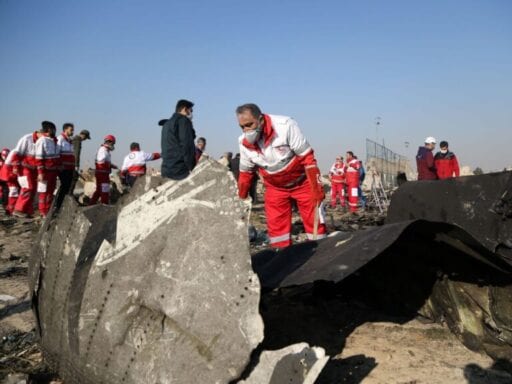A passenger plane bound for Kyiv crashed outside Tehran Wednesday. All 176 on board were killed.
Hours after Iran launched an attack against US forces stationed in Iraq in retaliation for the killing of Quds Force leader Maj. Gen. Qassem Soleimani, a passenger plane carrying 176 people crashed near Tehran. No one aboard the airplane is believed to have survived the crash, which happened Wednesday morning local time.
The plane, a Ukraine International Airlines flight from Tehran to Kyiv, was a Boeing 737-800 — not a 737 Max, the Boeing plane plagued by technical issues that has been grounded after being involved in two deadly crashes in 2018.
Din Mohammad Qassemi, who lives near the crash site, told the Associated Press he initially believed the US was retaliating for the strike on coalition forces in Iraq: “I heard a massive explosion and all the houses started to shake. There was fire everywhere. At first I thought [the Americans] have hit here with missiles and went in the basement as a shelter. After a while, I went out and saw a plane has crashed over there. Body parts were lying around everywhere.”
There is currently no evidence, however, that the crash is related to any military action. The cause of the crash is still under investigation.
/cdn.vox-cdn.com/uploads/chorus_asset/file/19585843/GettyImages_1192512215.jpg) AFP via Getty Images
AFP via Getty ImagesYevhen Dykhne, Ukrainian International Airlines president, seemed to suggest he doesn’t believe pilot error to be at fault. He said Wednesday, “It is impossible that there were mistakes by the crew.” He also called the 737, which was bought new in 2016, “one of the best planes we had.”
The story is still developing. Here’s what we know, and what we don’t.
What we know
- Ukraine International Airlines Flight PS752, a 3.5-year-old Boeing 737-800, departed Tehran Imam Khomeini International Airport at 6:12 am local time after sitting on the runway for roughly an hour.
- Shortly after takeoff, the plane crashed in farmland near Shahedshahr, a town about 30 miles southwest of Tehran and about 10 miles northwest of the airport.
- All 176 people — 167 passengers and nine crew members — on board are believed to have died.
- Ukraine International Airlines has published a list of the victims on its website.
- Vadym Prystaiko, Ukraine’s foreign minister, said there were 82 Iranians, 63 Canadians, 11 Ukrainians (two passengers and the nine crew members), 10 Swedish nationals, four Afghans, three Germans, and three British nationals on board.
- The plane’s black box (which records instrument readings and pilot conversations) has been recovered and is in Iran’s possession.
- Ali Abedzadeh, Iran’s top civilian aviation official, said the country will not give the box to Boeing or the US for analysis. He said data would be shared with Ukraine, however.
- Ukrainian International Airlines, Ukraine’s flag-carrier airline, has temporarily suspended all flights to Tehran.
- Ukrainian President Volodymyr Zelensky asked for calm and patience, saying he is “personally involved in supervision over all measures to be taken.” He also directed Ukrainian prosecutors to begin a criminal inquiry into the crash.
- Leaders of other affected countries have extended their condolences to the victims’ families, and have offered their countries’ expertise to investigators. Canada’s foreign minister, for instance, said, “Our hearts are with the loved ones of the victims, including many Canadians.”
What we don’t know
- The cause of the crash — Iran’s state news agency has reported an engine fire was the cause; Ukrainian officials issued a similar statement before retracting it, citing the need for more information.
- Whether the crash was related to Iran’s missile attacks. Ahead of its investigation, Iran has said a technical malfunction is to blame; the US has not issued an official statement on the matter.
.
Author: Sean Collins
Read More



